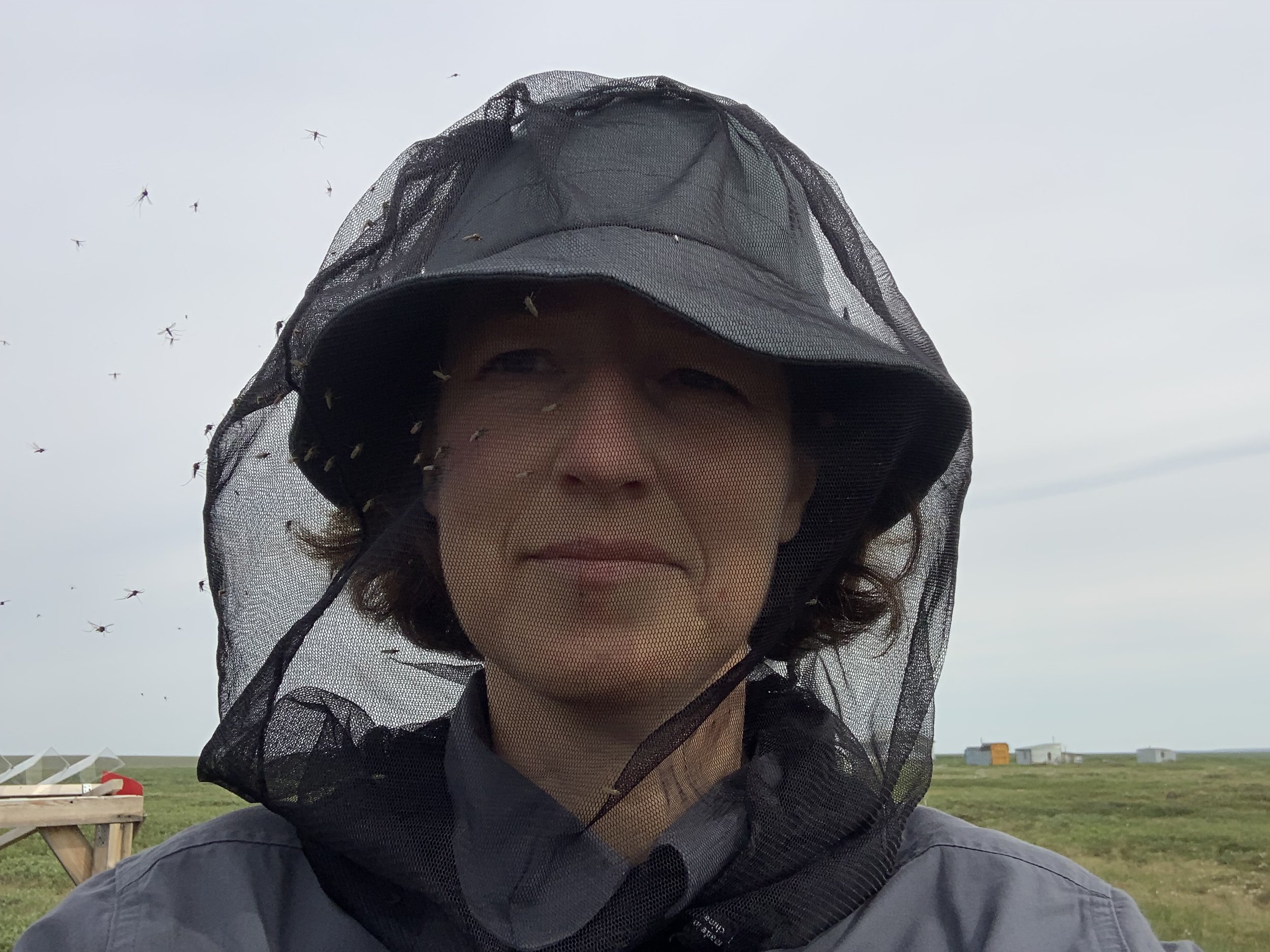Thin Green Skin Covering Permafrost – Yet Another Reason to Care About Arctic Vegetation
Gabriela Schaepman-Strub
Department of Evolutionary Biology and Environmental Studies, University of Zurich, Switzerland
Jacqueline Oehri
Department of Evolutionary Biology and Environmental Studies, University of Zurich, Switzerland and Department of Biology, McGill University, Montréal, QC, Canada
“Arctic tundra vegetation is a vulnerable green skin that mediates energy fluxes between the atmosphere and permafrost – let’s keep it intact!”
The still largely pristine terrestrial Arctic is often seen as last frontier for industrial development. At pan-Arctic scale, we recently found that only about 5% of the area is impacted by industrial activity as indicated by nighttime light observed from satellites (Akandil et al., 2024). However, Arctic industrial activity shows distinct regional hotspots and is increasing fast, fostered by amplified climate warming. Oil and gas extraction, mining, tourism - all together threaten the vulnerable, slow terrestrial ecosystem of the Arctic and its permafrost. Vegetation of the extensive area north of the treeline, the tundra, is often perceived as less 'valuable' compared to the tropics due to the relatively low number of plant species. However, the Arctic harbors a remarkable variety of vegetation types of different form and function. For example, when seismic exploration trailers cross the tundra, they compress the vulnerable vegetation, ultimately altering species composition and reducing the thermal insulation function of the vegetation - and leaving long lasting traces in the form of permafrost degradation. The Arctic permafrost holds approximately twice the carbon amount currently in the atmosphere. A key boundary condition of permafrost thaw and release of carbon to the atmosphere is the land surface energy budget, describing how much energy the land surface is taking up that is available for warming the soil and thawing the permafrost. It is often assumed that land surface energy fluxes in the Arctic are primarily driven by non-living factors such as latitude, air temperature, or cloud cover.
Our research team studies the impact of living factors. We study how different Arctic vegetation types, with their architecture and biophysical functions, influence land surface energy fluxes. Based on our comprehensive, pan-arctic data set shared among a large international collaboration team, we show that vegetation type strongly contributes to the regulation of land surface energy fluxes during Arctic summer. This is especially true for the partitioning of the absorbed energy towards the atmosphere and permafrost as well as the seasonal timing of snow cover. The results from our synthesis study indicate that different vegetation types can influence the energy exchange with the atmosphere strongly - and this difference can be as high as between vegetated and glaciated surfaces. Hence, future regional climate is related to the development of Arctic vegetation composition. Large-scale land use change and related change in vegetation type and function through for example industrial development or afforestation might further increase climate warming. Currently, these vegetation types are often not represented in Earth system models, leading to large uncertainties in Arctic - and ultimately global - climate predictions.
With our work, we contribute to the assessment of the net climate effect of different Arctic vegetation types to improve future climate predictions, as well as inform land management policies, including regulations for industrial development, evaluation of new protected areas that are critical to maintain biodiversity and ecosystem functions, fire management, afforestation or expansion of agriculture in northern high latitudes. Our scientific results can inform Arctic Nations, Indigenous Peoples, and stakeholders toward a positive vision and management of the terrestrial Arctic and its biodiversity under current amplified warming. As the study is based on data collected across the Arctic, spanning all major vegetation types, it can be applied at larger scale, while we have identified and documented important gaps in the representativeness of the data that need to be filled in the future.
This work is significant because it supports a sustainable development of the Arctic, by highlighting the important functions of the Arctic tundra ecosystem, often perceived as vast landscape of low biodiversity value. We emphasize its importance for land surface energy fluxes, and suggest careful evaluation of land use change that might increase pressure on permafrost degradation, in addition to climate change alone. We hope that this knowledge will help with reducing the risk of fast industrial development and supports careful management and protection of functionally critical areas. The vast Arctic landscapes are a key component of Indigenous livelihoods, are fundamental for keystone species of global biodiversity such as migratory birds and reindeer, and permafrost is one of the tipping points of the global climate. Vegetation forms a basis for all these functions, hence a better understanding and representation of vegetation interactions in the Earth system and its modeling is timely and urgently needed to contribute to the decision making processes towards a sustainable management of the fast changing Arctic tundra landscapes.
Our research is directly related to several planetary boundaries: the climate system (addressing permafrost degradation through vegetation change, and hence a positive feedback to climate warming), biosphere integrity, and land-system change. As the Arctic with its vast land- and sea-scapes is under growing economic and geopolitical pressure, it will increasingly contribute towards pushing novel entities - yet another planetary boundary- through oil and gas mining, gas flares, pipelines, and related light pollution, as well as related shipping activities along the northern sea routes. With our research, highlighting the importance of vegetation type and land cover management in the Arctic to regulate surface energy fluxes, we hope to also limit the development of these novel entities, as they might develop toward major drivers for large-scale transformation of Arctic landscapes (Akandil et al., 2024).
With the 5th International Polar Year currently under planning for 2032/2033, we have a unique opportunity to address planetary science questions in the Arctic and Antarctic. This is done through performing coordinated field measurements on land and in the ocean and atmosphere, improving the representation of Arctic vegetation functions in Earth system models, designing large-scale synthesis studies integrating these new data and spanning across disciplines and networks, and ultimately co-designing options and potential solutions in collaboration with Indigenous Peoples.
Photo 1. National Champion Gabriela Schaepman-Strub in the Siberian tundra, bearing with the mosquitos during field work (self portrait).
Photo 2. National Champion Gabriela Schaepman-Strub (2nd left) with postdoc and First Author Jacqueline Oehri (last on right) in the Siberian tundra after building up a rainfall experiment (30 sheltered plots, some visible in the background) to understand the effects of extreme precipitation (drought and increased summer rainfall) onto vegetation composition and permafrost thaw. @Sergey Karsanaev.
Reference
Akandil, Cengiz, Elena Plekhanova, Nils Rietze, Jacqueline Oehri, Miguel O. Roman, Zhuosen Wang, Volker Radeloff, and Gabriela Schaepman-Strub. Artificial light at night reveals hotspots and rapid development of industrial activity in the Arctic. No. EGU24-4091. Copernicus Meetings, 2024.




